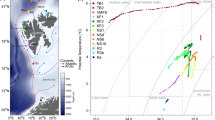Abstract
Copepods (Class Crustacea, Order Copepoda) are rarely included in paleoecological studies of lakes because they lack long-lasting exoskeletal remains. We describe the remains of eggs (egg shells) from Hesperodiaptomus copepods that are well preserved and abundant in alpine lake sediments. We demonstrate that the egg shells are the remains of Hesperodiaptomus eggs based on (i) the similar size and morphology of egg shells collected from sediments and those produced from the hatching of eggs obtained from laboratory-maintained Hesperodiaptomus, and (ii) the finding that diapausing eggs collected from lake sediments and hatched in the laboratory produced copepod nauplii that were morphologically indistinguishable from those hatched from eggs produced by laboratory-maintained Hesperodiaptomus. Egg shells were approximately two orders of magnitude more abundant in sediment cores than were viable diapausing eggs, making egg shells superior to viable diapausing eggs for quantifying the historical presence and abundance of Hesperodiaptomus. These results have important implications for alpine lake restoration as egg shells can be used to identify lakes in which Hesperodiaptomus was eliminated by fish introductions but has failed to return after fish eradication, lakes in which the pre-disturbance conditions are likely to be restored only by reintroductions of this important taxon.
Similar content being viewed by others
References
Anderson, R. S., 1980. Relationships between trout and invertebrate species as predators and the structure of the crustacean and rotiferan plankton in mountain lakes. In Kerfoot, W. C. (ed.), Evolution and Ecology of Zooplankton Communities. The University Press of New England, Hanover (N.H.) & London, 635–641.
Bennike, O., 1998. Fossil egg sacs of Diaptomus (Crustaceae: Copepoda) in Late Quaternary lake sediments. J. Paleolim. 19: 77–79.
Bradford, D. F., S. D. Cooper, T. M. Jenkins, Jr., K. Kratz, O. Sarnelle & A. D. Brown, 1998. Influences of natural acidity and introduced fish on faunal assemblages in California alpine lakes. Can. J. Fish. Aquat. Sci. 55: 2478–2491.
Carlisle, D. M. & C. P. Hawkins, 1998. Relationships between invertebrate assemblage structure, 2 trout species, and habitat structure in Utah mountain lakes. J. N. Am. Benthol. Soc. 17: 286–300.
Frey, D. G., 1964. Remains of animals in Quaternary lake and bog sediments and their interpretation. Arch. Hydrobiol., suppl. Ergebn. Limnol. 2: 1–116.
Fisher, M. M., M. Brenner & K. R. Reddy, 1992. A simple, inexpensive piston corer for collecting undisturbed sediment/water interface profiles. J. Paleolim. 7: 157–161.
Hairston, N. G., Jr. & E. J. Olds, 1984. Population differences in diapause timing: adaptation in a spatially heterogeneous environment. Oecologia 61: 42–48.
Hairston, N. G., Jr., R. A. Van Brunt, C. M. Kearns & D. R. Engstrom, 1995. Age and survivorship of diapausing eggs in a sediment egg bank. Ecology 76: 1706–1711.
Knapp, R. A., 1996. Nonnative trout in natural lakes of the Sierra Nevada: an analysis of their distribution and impacts on native aquatic biota. In Sierra Nevada Ecosystem Project: final report to Congress. Volume III. Centers for Water and Wildland Resources, University of California, Davis, pp. 363–407 (available online at ceres.ca.gov/snep/pubs).
McNaught, A. S., D. W. Schindler, B. R. Parker, A. J. Paul, R. S. Anderson, D. B. Donald & M. Agbeti, 1999. Restoration of the food web of an alpine lake following fish stocking. Limnol. Oceanogr. 44: 127–136.
Paul, A. J. & D. W. Schindler. 1994. Regulation of rotifers by predatory calanoid copepods (subgenus Hesperodiaptomus) in lakes of the Canadian Rocky Mountains. Can. J. Fish. Aquat. Sci. 51: 2520–2528.
Parker, B. R., F. M. Wilhelm & D. W. Schindler, 1996. Recovery of Hesperodiaptomus arcticus populations from diapausing eggs following elimination by stocked salmonids. Can. J. Zool. 74: 1292–1297.
Pennak, R. W., 1989. Freshwater invertebrates of the United States: Protozoa to Mollusca. John Wiley, New York, 628 pp.
Stoddard, J. L., 1987. Microcrustacean communities of highelevation lakes in the Sierra Nevada, California. J. Plankton Res. 9: 631–650.
Wood, S. H., 1977. Distribution, correlation, and radiocarbon dating of late Holocene tephra, Mono and Inyo craters, eastern California. Geol. Soc. Bull. 88: 89–95.
Author information
Authors and Affiliations
Rights and permissions
About this article
Cite this article
Knapp, R., Garton, J. & Sarnelle, O. The use of egg shells to infer the historical presence of copepods in alpine lakes. Journal of Paleolimnology 25, 539–543 (2001). https://doi.org/10.1023/A:1011178406716
Issue Date:
DOI: https://doi.org/10.1023/A:1011178406716




